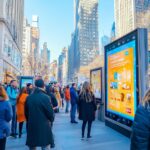Marketing is essential for attracting visitors to national parks, ensuring that these natural treasures receive the attention they deserve. This article examines effective marketing strategies tailored specifically for national parks and how leveraging visitor movement data and marketing automation tools can significantly enhance these initiatives. It defines visitor movement data, outlines its benefits, and presents inspiring case studies that highlight successful campaigns. Furthermore, best practices are offered to assist parks in optimizing their marketing efforts through strategic planning and audience segmentation. Join us as we explore the dynamic intersection of nature, eco-tourism, and data-driven marketing.
The Importance of Marketing for National Parks

Marketing plays a crucial role in the success of National Parks by enhancing brand awareness, fostering audience engagement, building visitor loyalty, promoting environmental sustainability, and supporting conservation efforts.
Effective marketing strategies can significantly influence visitor patterns and behaviors, ensuring that National Parks remain accessible and attractive to a diverse range of users through targeted advertising and interactive experiences.
By utilizing data-driven decision-making, trend analysis, and targeting specific audience segments, National Parks can create tailored experiences for eco-tourism and nature-based tourism audiences.
Ultimately, successful marketing not only bolsters conservation efforts but also enhances the overall visitor experience and drives tourism revenue.
Benefits of Effective Marketing Strategies
Effective marketing strategies offer numerous advantages to national parks by enhancing visitor experiences, increasing retention, encouraging community involvement, and promoting park facilities. One valuable tool is Visitor Movement Data, which provides insights into visitor behavior, movement patterns, and visitor demographics. This data allows parks to manage resources, facilities, and visitor safety more effectively in order to meet visitor needs.
In a similar vein, marketing metrics and visitor insights can provide parks with insights into their current visitor engagement levels, helping to identify which outreach tactics have been most effective. Key engagement metrics include visit levels on social media platforms, blog readership, email open rates, and user-generated content. For parks, these metrics reveal optimal communication timing and frequency while informing management decisions related to seasonal trends, audience demographics, and marketing effectiveness.
This information is particularly useful for outreach programs aimed at increasing visitor numbers, as it helps management determine the best ways to engage the public about upcoming events and programs. Campaigns utilizing this data can include personalized communications, socially-distanced events, online programs, and interactive maps, all of which can lead to heightened engagement among diverse audience segments.
For instance, if Visitor Movement Data indicates a significant number of visits during weekdays but a drop on weekends, a park might create a marketing campaign that encourages families to visit on weekends by offering group-friendly events and park events promotion.
Marketing outreach campaigns can also effectively engage the local community, such as programs that involve local youth in park stewardship activities, community outreach, or initiatives that give the power to residents to become park ambassadors. These ambassadors can share the benefits of their parks with friends, family, and the online community, fostering a sense of ownership among community members and motivating them to promote local parks. This approach can lead to increased visitor numbers, particularly in parks located in or near urban areas.
While an increased number of visitors does not always correlate with heightened satisfaction, a consistent base of users who enjoy their experiences can become brand ambassadors, driving further growth and visitor retention. Community outreach programs can also enhance visitor satisfaction and strengthen the relationship between the community and the natural environment, leading to more loyal visitors, repeat visits, and increased visitor loyalty.
Using Visitor Movement Data to Enhance Marketing

You can enhance marketing efforts in a National Park by utilizing Visitor Movement Data, which provides valuable insights into visitor behavior and engagement patterns, as well as supporting digital marketing initiatives.
By combining data analytics with this information, park management can track foot traffic, analyze visitor trends, conduct demographic analysis, and obtain real-time data to guide marketing strategies.
This data-driven approach enables parks to identify peak times, optimize facilities, and create tailored experiences that resonate with their target audience, ultimately resulting in increased visitor satisfaction, loyalty, and enhanced user experience.
What is Visitor Movement Data?
Visitor Movement Data refers to the collection and analysis of information regarding how visitors move and interact within National Parks, using tools such as visitor tracking and Geographic Information Systems (GIS). This data can be captured using various data collection tools and includes foot traffic analysis, visitor patterns, and engagement metrics.
By visualizing visitor behavior, park managers can optimize their marketing strategies accordingly, improving park accessibility and visitor satisfaction. Understanding how visitors navigate park facilities and attractions allows management to enhance the overall visitor experience, satisfaction, and environmental impact.
The significance of this data goes beyond simple visitor counts; it informs critical decisions related to park conservation, resource allocation, safety measures, and environmental stewardship. Various collection tools, such as GPS tracking, mobile applications, and camera analytics, provide invaluable insights into peak visitation times, popular trails, underutilized areas, and visitor feedback.
These insights give the power to park managers to manage foot traffic more effectively, allocate staff where needed, create targeted educational programs, and improve content marketing.
Data visualization techniques help transform raw data into comprehensible maps and graphs, enabling stakeholders to make informed, data-driven decisions and enhance visual storytelling. Ultimately, this approach enhances the natural beauty and integrity of the parks while ensuring an enjoyable experience and greater visitor engagement for every visitor.
How Can Visitor Movement Data Benefit National Park Marketing?

Visitor movement data can significantly enhance national park marketing by informing strategies that boost visitor engagement and experience personalization. By implementing data-driven decisions based on this information, park management can improve the overall visitor experience, optimize resource allocation, and increase marketing effectiveness. This approach leads to more targeted marketing strategies that effectively reach the desired audience through content strategy and cross-promotion.
Park management can utilize visitor movement data to gain insights into visitor patterns, peak times, the most popular attractions within the park, and behavioral patterns. With this knowledge, parks can develop marketing campaigns aimed at specific demographics and audiences, leveraging demographic analysis and visitor profiles. Additionally, visitor movement data can guide content development that appeals to potential visitors, thereby improving social media engagement, email campaigns, and website traffic.
By analyzing metrics such as visitor flow and preferences, parks can create personalized experiences that deepen visitors’ connections to nature, encourage repeat visits, and support customer relationship management (CRM). Ultimately, park management can leverage visitor movement data to enhance their marketing efforts, ensuring they attract and engage a diverse range of audiences while supporting sustainable practices.
Examples of Successful Marketing Campaigns using Visitor Movement Data
Many national parks have leveraged visitor movement data for their marketing campaigns, leading to greater visitor engagement, enhanced brand awareness, and improved park branding.
By utilizing visitor analytics and predictive analytics, these parks have been able to tailor their marketing messages and promotional initiatives to effectively resonate with their target audience.
The following case studies illustrate how data-driven insights can influence marketing campaigns, resulting in improved visitor experiences, increased retention rates, and better customer journey mapping.
Case Studies of National Parks Implementing Visitor Movement Data

Several national parks have implemented Visitor Movement Data to enhance their marketing strategies, achieving successful results, improving visitor behavior analysis, and supporting market segmentation.
Yellowstone National Park is one such park that utilized visitor tracking technology and Geographic Information Systems (GIS) to identify traffic patterns and congestion areas. Through this analysis, park managers discovered that certain trails were overcrowded at specific times of the day, guiding strategic planning.
Consequently, the park adjusted its marketing campaigns to promote less popular trails, encouraging visitors to explore alternative routes and supporting wayfinding solutions. This strategy not only reduced congestion but also enhanced the visitor experience by showcasing lesser-known features of the park and promoting visitor education.
This case study demonstrates that data analytics can provide operational efficiencies while also creating a more enjoyable experience for visitors, enhancing the overall user experience.
Best Practices for Utilizing Visitor Movement Data in National Park Marketing
Effective use of Visitor Movement Data involves audience segmentation, which helps maximize marketing performance for National Parks while safeguarding data privacy, maintaining visitor trust, and supporting sustainable practices.
Audience segmentation refers to the process of dividing visitors into groups based on shared characteristics or behaviors, such as visitor profiles and demographic analysis. These characteristics can include demographic factors, such as age or nationality, as well as behavioral traits, such as visit frequency, preferred activities, feedback on park management’s services and amenities, and travel behavior.
By segmenting visitors, park management can develop more effective marketing strategies, allowing them to send tailored messages that resonate with specific audience groups through targeted advertising and content marketing. This approach not only enhances the quality of marketing campaigns but also improves the visitor experience by providing relevant and timely information and supporting visitor engagement.
It is essential for parks to comply with local and international data privacy laws, such as the GDPR, as well as ethical standards regarding data usage to establish and maintain trust with their visitors, ensuring responsible data-driven decisions.






